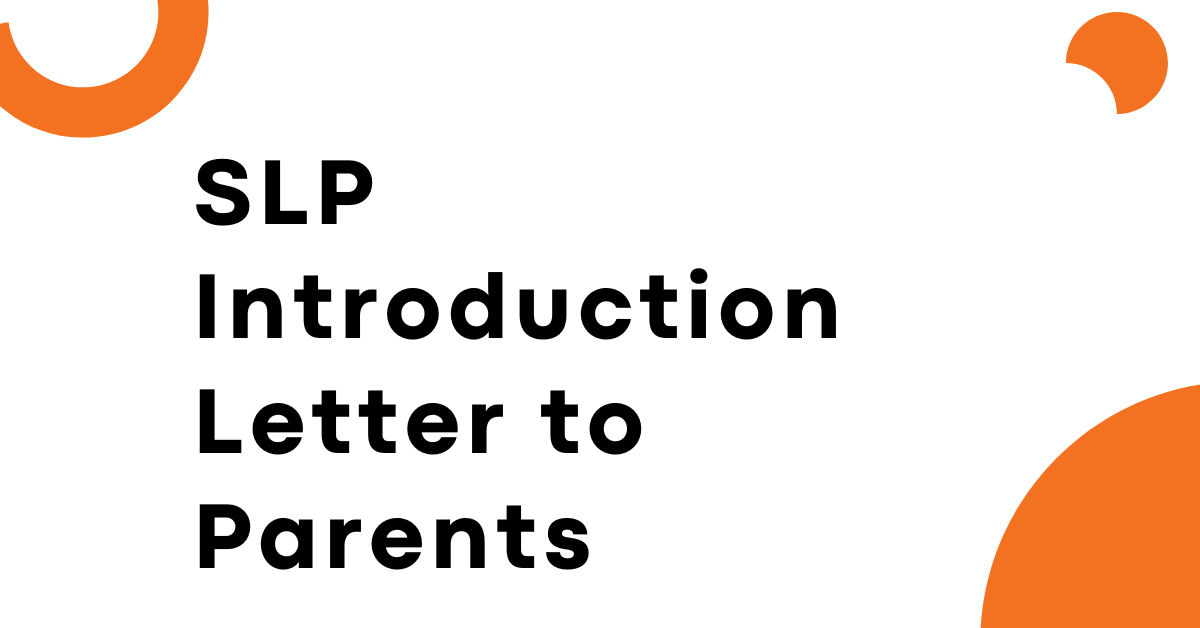A Speech-Language Pathologist (SLP) Introduction Letter to Parents is a formal communication sent by an SLP to introduce themselves and their services to parents or guardians of children who may benefit from speech-language therapy. Its purpose is to establish a positive relationship, provide important information about the SLP’s background, expertise, and approach to therapy, and encourage parents to consider therapy for their child.
In this article, we will provide you with templates and examples of SLP Introduction Letters to Parents. These samples will serve as a guide to help you craft your own letter effectively. Whether you are a new SLP looking to introduce yourself to parents or an experienced SLP wanting to update your introductory letter, our samples will assist you in creating a professional and informative communication.
Our goal is to make the process of writing an SLP Introduction Letter to Parents as simple and straightforward as possible. With our templates and examples, you can easily customize your letter to reflect your specific style and approach to therapy.

Sample of a SLP Introduction Letter to Parents
[Your Name]
[Your Address]
[City, State, Zip Code]
[Email Address]
[Phone Number]
[Date]
[Parent’s Name]
[Parent’s Address]
[City, State, Zip Code]
Dear [Parent’s Name],
I am writing to introduce myself as the Speech-Language Pathologist (SLP) who will be working with your child. My name is [Your Name], and I am excited to have the opportunity to work with your family.
I have a [X years] experience working with children with speech and language disorders. I hold a [Your Degree] in Speech-Language Pathology from [Your University], and I am licensed to practice in [Your State]. My approach to therapy is holistic, focusing on the individual needs of each child to achieve the best possible outcomes.
I look forward to meeting you and your child and working together to help them reach their full potential. Please feel free to contact me at [Your Phone Number] or [Your Email Address] if you have any questions or concerns.
Sincerely,
[Your Name]
How to Write a SLP Introduction Letter to Parents
Writing an effective SLP Introduction Letter to Parents is crucial for establishing a positive relationship and providing important information about your services. Here’s a step-by-step guide on how to write this letter:
1. Understand Your Audience:
Before you begin writing, understand the parents’ perspective and what they may be looking for in an SLP for their child.
2. Introduce Yourself:
Start by introducing yourself and providing some background information, such as your qualifications, experience, and areas of expertise.
3. Explain Your Approach:
Describe your approach to speech-language therapy and how you tailor your services to meet the individual needs of each child.
4. Highlight Benefits:
Highlight the benefits of speech-language therapy for children, such as improved communication skills, confidence, and academic performance.
5. Provide Contact Information:
Include your contact information, such as your phone number and email address, so parents can easily reach you with any questions or concerns.
6. Offer a Consultation:
Offer to schedule a consultation with the parents to discuss their child’s needs and how you can help.
7. Close Professionally:
Close your letter with a professional sign-off, such as “Sincerely” or “Best regards,” followed by your name and signature.
By following these steps, you can write a compelling SLP Introduction Letter to Parents that effectively communicates your qualifications, approach, and commitment to helping their child succeed.
Things to Keep In Mind
1. Personalize the Letter:
Tailor your letter to each parent and child by mentioning specific concerns or goals related to their speech and language development.
2. Focus on the Child’s Needs:
Highlight how your expertise and approach can specifically benefit their child, making the letter more compelling and relevant.
3. Highlight Your Credentials:
Emphasize your qualifications, experience, and any specialized training you have that sets you apart as an SLP.
4. Use Positive Language:
Use positive language to convey optimism and confidence in your ability to help the child improve their communication skills.
5. Provide Clear Contact Information:
Make it easy for parents to reach you by providing your phone number, email address, and office hours.
6. Offer a Consultation:
Invite parents to schedule a consultation to discuss their child’s needs in more detail and to learn more about your approach to therapy.
7. Follow Up:
After sending the letter, follow up with a phone call or email to ensure that parents received the letter and to answer any questions they may have.
FAQs about a SLP Introduction Letter to Parents
When writing an SLP Introduction Letter to Parents, it’s important to address common questions they may have. Here are some FAQs and their answers:
1. What Is the Purpose of an SLP Introduction Letter to Parents?
The purpose of the letter is to introduce the speech-language pathologist (SLP) to parents, provide information about their qualifications and approach to therapy, and establish a positive relationship.

2. How Should I Address the Letter?
Address the letter to the parents or guardians of the child receiving therapy. Use a formal salutation, such as “Dear [Parent’s Name],”
3. What Information Should I Include in the Letter?
Include your name, qualifications, experience, approach to therapy, and contact information. Also, mention any specific concerns or goals related to the child’s speech and language development.
4. How Can I Make the Letter Personalized?
Personalize the letter by mentioning specific details about the child’s needs or goals. This shows that you have taken the time to understand their situation.
5. What Should I Do After Sending the Letter?
After sending the letter, follow up with a phone call or email to ensure that parents received it and to answer any questions they may have. This shows your commitment to their child’s therapy.
RELATED:
Permission Letter to Take Child to Doctor
Late Pick up Letter to Parents
Landlord Letter to Tenant Proof of Residence
